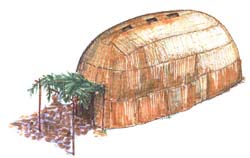
 |
Move mouse over image to view inside. enlarge |
Their Cabins are very large, and are Roofed and floored with mats made of Rushes. (Jacques Marquette, 1674)![]()
The Illinois lived in several different kinds of houses, some of which were large enough to provide shelter for as many as ten families. In their summer villages they built long-rectangular structures, called "longhouses," which were semicylindrical in shape. The Illinois longhouse was constructed by erecting a pole framework and covering it with one or two layers of woven reed mats. A single doorway, shaded by a porch-like awning, was placed at one end of the structure. The interior of each longhouse was subdivided into separate living quarters for different families. Four or five hearths were placed in a row down the middle of the house, each fire serving the needs of two families. Based on archaeological excavations at an Illinois village located in northeastern Missouri, longhouses measured up to 17.8 meters (58 feet) long and 7.2 meters (24 feet) wide. The height of the roof is not known, but may have been up to 4.5 meters (15 feet) above the ground.
The houses constructed at winter villages were relatively small structures called "wigwams." Wigwams were dome-shaped, had oval floor plans, and probably were occupied by one or two families. Like the longhouses, they had bent-pole frames and were covered with layers of reed mats. Winter houses were portable, and each fall women carried the materials used to make them from the summer village to the winter village. Wigwams were much smaller than longhouses. Based on archaeological excavations in Illinois and Missouri, they measured about 7 meters (23 feet) long and 4 meters (13 feet) wide. The highest elevation of the roof may have been about 3 meters (10 feet) above the ground.
At their summer hunting camps, which were located in prairies near the prairie-forest border, the Illinois built temporary structures that were occupied briefly while they hunted for bison and other game animals. These hunting lodges had pole frameworks and may have been similar in shape to the wigwams occupied at winter villages. However, unlike the mat-covered winter houses, hunting lodges were covered with bark that women stripped from trees in the nearby forests.
Illinois women made reed or rush mats using the stems of plants that they gathered in marshes. Historical sources do not tell us the specific kinds of plants used, but they probably included both cattails (Typha) and bulrushes (Scirpus). After harvesting the stems, women cut them to a uniform length of about 5-6 feet and laid them out to dry. Then they wove the stems together using numerous strands of twine made from long strips of a white wood (probably basswood, Tilia americana). The completed mats, which measured up to 60 feet long, were applied to the roofs and floors of longhouses and wigwams. When new, a double layer of reed mats was water-resistant and provided protection from rain and snow.![]()
|
|
Copyright © 2000 Illinois State Museum